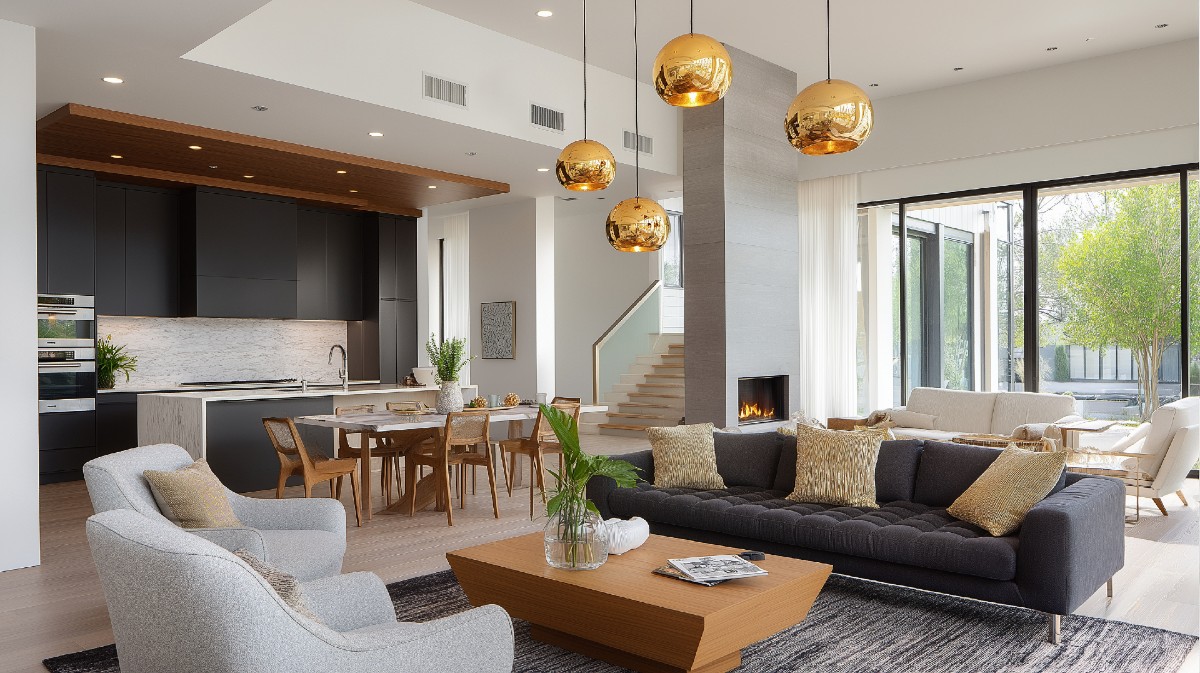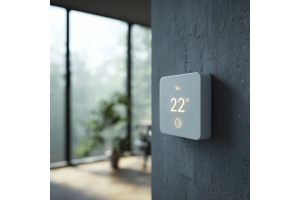
Why Heating Open-Plan Spaces Is Challenging
Open-plan living may be beautiful and modern, but from a heating perspective, it can be a tough nut to crack. Unlike traditional rooms, where radiators only need to warm a confined and insulated area, open-plan layouts remove many of the structural and thermal boundaries that help keep heat where it’s needed. Below is a detailed breakdown of the specific challenges that homeowners and designers face when trying to heat these expansive environments effectively.
1. Lack of Internal Walls Means Heat Disperses Freely
Walls in traditional homes act like thermal barriers, helping to trap heat in specific rooms. In open-plan layouts, however, there are fewer (or no) walls to contain warmth. This creates several problems:
-
Heat travels unpredictably across the open space.
-
No temperature zoning: It’s harder to keep one part warm without overheating others.
-
More heating power needed to maintain consistent temperatures across the entire area.
As a result, a radiator that could easily warm a 20m² room might struggle to have any noticeable effect in an open-plan 50m² living-dining-kitchen combo.
2. High Ceilings Create Heat Stratification
Many open-plan homes feature vaulted ceilings, mezzanines, or double-height atriums, which look impressive but cause heat to behave in counterproductive ways.
-
Warm air rises, leaving the lower areas—the ones we occupy—cooler.
-
Uneven heating leads to cold spots at seating level and excess heat trapped near the ceiling.
-
More energy is required to heat the space because so much of it escapes upward.
Unless ceiling fans, radiant heating, or careful heat circulation strategies are employed, homeowners often find themselves cranking up the thermostat without feeling much benefit.
3. Large Surface Areas Require Greater Heating Output
The surface area of walls, floors, and ceilings in open-plan layouts is significantly larger, meaning more heat is lost through conduction—especially if insulation is poor. Furthermore:
-
Air volume increases dramatically with open plans—especially if the layout includes stairwells or connecting levels.
-
A typical 3-bedroom home might have around 120–150 m² of space, and heating an open-plan area that spans a third or half of that requires substantially more BTUs than a standard living room.
In essence, heating demand is not linear with floor space—it's exponential due to the volume of air and surface area exposed.
4. Expansive Windows and Glazed Doors Drain Heat
One of the main features of modern open-plan living is the use of large glass elements such as:
-
Floor-to-ceiling sliding doors
-
Bi-fold walls
-
Skylights and glazed atriums
While these features bring in natural light and connect indoor and outdoor spaces, they are also notoriously inefficient insulators, especially if double-glazing or low-emissivity coatings aren't used.
-
Glass conducts heat more than walls—leading to faster heat loss.
-
Radiators placed nearby may be working harder than necessary to combat drafts.
-
Condensation and cold zones often form near windows, making those areas feel cooler.
5. Inefficient Zoning and Thermostat Placement
In closed-off rooms, thermostats can accurately measure and control temperature. In open-plan spaces:
-
Thermostat readings may not reflect comfort in seating or dining zones, especially if placed near windows or radiators.
-
Heat may be wasted warming lesser-used zones, such as hallways or entrances.
-
Single-zone systems can’t adapt to varied use of space throughout the day.
For example, you may want the kitchen cooler while cooking, but the lounge area warmer while relaxing—without zoning, this is difficult to manage.
6. Furniture Layout and Airflow Disruption
Open-plan layouts often include multifunctional furniture arrangements, such as:
-
Sofas in the middle of the room
-
Kitchen islands
-
Open shelving units or media walls
These can unintentionally block radiators or restrict airflow, especially if placed directly in front of heating sources. The result is poor circulation of warm air, cold drafts, and hot/cold pockets around the room.
Additionally, the lack of natural airflow boundaries like doors or partitions can result in heat being drawn away from occupied spaces and unevenly distributed.
7. Greater Dependence on Supplemental Heating
Because of all these challenges, open-plan homes often end up relying on portable heaters, electric panels, or underfloor heating to supplement traditional radiators. This can lead to:
-
Increased energy consumption
-
Higher heating bills
-
Uneven comfort levels, depending on the zone or time of day
It’s a sign that the heating system isn’t tailored properly to the space—a common oversight in open-plan renovations or extensions.
8. Acoustic and Thermal Echo Chambers
Heat isn’t the only thing that travels easily in an open-plan home. Sound does too. This matters because:
-
Heating systems like fan-assisted or convector units may become noticeable noise sources.
-
High ceilings and hard surfaces (e.g., tiles, glass, metal) can reflect both heat and sound—creating an uncomfortable echo and inefficient thermal environment.
The lack of soft furnishings and enclosed corners means both sound and heat bounce around or escape without settling in usable zones.
The Takeaway
Open-plan spaces offer stunning visuals and modern flexibility, but these same features create unique heating challenges:
-
Heat loss is greater and harder to control.
-
Heat circulation becomes more unpredictable.
-
Radiators and heating controls must be carefully chosen and positioned.
Understanding these obstacles is the first step toward designing an efficient, comfortable open-plan living environment—and selecting the right radiators and heating layout is key to getting it right.
How to Heat an Open-Plan Space Effectively
Open-plan living may look clean and contemporary, but it requires a well-thought-out heating strategy to ensure comfort and efficiency. Unlike traditional room layouts, heating an open-plan area isn’t as simple as placing one or two radiators on exterior walls. You’ll need to balance heating output, placement, insulation, and control systems to effectively warm the space without creating hot/cold zones or wasting energy.
Below are the most effective methods to achieve optimal heating in open-plan homes:
1. Choose Radiators with a High Heat Output (BTU)
The first rule of heating a large space is matching your BTU requirement—this ensures you’re not under-heating (leading to a cold space) or overcompensating (wasting energy and money).
What to Do:
-
Use a BTU calculator to determine how many British Thermal Units are needed based on:
-
Floor area
-
Ceiling height
-
Glazing
-
Wall insulation
-
Number of external doors
-
-
Multiply BTUs if you’re using multiple radiators across the space.
-
Select radiators with high BTU per square inch, such as aluminium or dual-panel models.
Try Geyser’s BTU Calculator to determine your needs before shopping.
2. Use Multiple Radiators to Zone the Space
Relying on a single large radiator to heat a 40–60m² space is inefficient and will leave corners cold. Instead, install several smaller radiators in key zones to maintain even heat distribution and give you flexible control over the environment.
Create Heating Zones:
-
Lounge zone: Use a designer or vertical radiator to complement your style.
-
Dining area: Consider slimline radiators beneath windows or against feature walls.
-
Kitchen: Use electric radiators or underfloor heating to save wall space.
By zoning your open-plan layout, you:
-
Avoid heat loss in low-traffic areas
-
Improve comfort in seating and activity areas
-
Reduce energy use by only heating the zones you’re using
3. Use Fast-Responding Radiator Materials Like Aluminium
In open-plan layouts, heat can be lost quickly through large volumes of air and high ceilings. That’s why you need radiators that respond fast—both heating up and cooling down quickly to match usage patterns.
Why Aluminium Works Best:
-
Heats up in minutes, reducing lag time
-
Lightweight, making it easier to install multiple units
-
Highly conductive, so less energy is wasted
-
Available in modern designer styles to complement open-plan aesthetics
Explore Geyser’s Aluminium Radiators for Efficient Heating
4. Consider Vertical Radiators for Better Circulation
Open-plan areas often include large windows, limited wall space, or awkward layouts. In such cases, vertical radiators are your best friend:
-
Tall and slim to fit narrow wall sections
-
Help circulate heat higher into double-height spaces
-
Double as design elements—ideal for contemporary homes
Place vertical radiators:
-
Next to patio doors or windows
-
Near seating zones
-
In architectural nooks or alcoves
See Geyser’s Vertical Radiator Collection for Style + Performance
5. Supplement with Underfloor Heating in Key Areas
Underfloor heating (UFH) is an excellent complement to traditional radiators in open-plan homes. While not always sufficient on its own, UFH offers even heat spread and removes the need for visible heating units.
Best Used In:
-
Kitchens with tile or stone flooring
-
High-traffic areas
-
Zones with limited wall space
Electric UFH is ideal for retrofits, while wet systems (plumbed into your central heating) are better for new builds or major renovations.
Tip: Pair underfloor heating with aluminium radiators in larger zones for dual-layer warmth and rapid responsiveness.
6. Control Zones with Smart Thermostats and TRVs
One of the biggest mistakes in open-plan heating is using a single thermostat to manage a large area. This causes uneven temperatures and energy waste.
Best Practice:
-
Install smart thermostats for each zone (kitchen, lounge, dining).
-
Use thermostatic radiator valves (TRVs) to control each radiator individually.
-
Program schedules for different zones depending on when you use them.
For example:
-
Warm the kitchen at breakfast and dinner.
-
Reduce heat in unused areas.
-
Keep the lounge warm during evenings and weekends.
Smart controls also allow remote access, so you can adjust heating before you get home—perfect for energy-conscious families.
7. Improve Insulation to Reduce Heat Loss
Before over-engineering your heating system, check the envelope of your home. A properly insulated home will retain heat more effectively, making every watt from your radiators count.
Insulation Tips for Open-Plan Spaces:
-
Double- or triple-glazed windows to reduce thermal transfer
-
Heavy, lined curtains or thermal blinds for evening insulation
-
Draught-proof doors, especially sliding or bi-fold doors
-
Upgrade wall and roof insulation in renovation projects
Did you know? Up to 35% of heat can be lost through poorly insulated walls or ceilings—especially in open-plan extensions.
8. Use Passive Heating Techniques to Your Advantage
Smart layout decisions and small changes can go a long way in improving comfort:
-
Place radiators under windows to counteract cold downdraughts.
-
Use thick rugs over hard floors to reduce heat loss and add comfort.
-
Install ceiling fans in double-height spaces to gently circulate warm air downwards.
-
Choose heat-retaining materials like stone, brick, or wood for interior surfaces.
-
Arrange seating away from drafty areas and near radiators where possible.
9. Style Meets Substance: Choose Designer Radiators
Open-plan living is about aesthetics as much as function. Radiators no longer need to be hidden—they can become statement pieces that enhance your interior:
-
Sculptural radiators in feature finishes (e.g., anthracite, brushed steel)
-
Vertical designer models with towel rails for open-plan bathroom areas
-
Radiators in bold colours to match accent decor
Your radiator doesn’t just heat the space—it completes the look.
Shop Geyser’s range of Designer Radiators
Summary: The Keys to Heating Open-Plan Spaces
| Strategy | Why It Matters |
|---|---|
| High-BTU Radiators | Deliver enough power for large volumes of air |
| Multiple Zones | Tailored heat for living, dining, kitchen |
| Aluminium or Vertical Radiators | Responsive and space-saving |
| Underfloor Heating | Seamless warmth and space efficiency |
| Smart Controls | Boost energy efficiency and comfort |
| Quality Insulation | Prevents heat loss |
| Passive Heating Design | Enhances system performance without extra cost |
Top Radiator Picks for Open-Plan Living
Choosing the right radiator for your open-plan space is about more than just heat output — it’s about efficiency, placement flexibility, responsiveness, and visual impact. Open-plan rooms require radiators that deliver substantial BTU performance, match your décor, and work well in a multi-zoned environment.
Here are our top recommended radiator types and models from the Geyser collection, selected specifically for their ability to perform beautifully and heat effectively in large, open spaces.
1. Luca Vertical Aluminium Radiator
Best For: Maximising wall height, fast heat-up time, modern spaces
Available in: Anthracite, White, and Raw Metal finishes
BTU Range: 2,500 – 10,000+ depending on size
Why It Works:
-
Crafted from lightweight aluminium, the Luca radiator heats up quickly — ideal for a room where warmth needs to be felt fast.
-
Its slim vertical design saves wall space, allowing you to install more than one unit without clutter.
-
Excellent for zones near tall windows, doorways, or between furniture where wall space is limited.
-
It has a minimalist, clean profile that blends effortlessly into modern interiors.
2. Milo Horizontal Designer Radiator
Best For: Stylish lounge and dining zones, feature walls
Available in: Anthracite and White
BTU Range: 3,000 – 8,000+
Why It Works:
-
This contemporary double-panel steel radiator is a perfect choice when you need substantial heating power without sacrificing style.
-
The sleek horizontal profile is ideal beneath windows or large glazed walls in open-plan layouts.
-
Available in multiple widths, making it easy to scale the output across zones.
-
Matches effortlessly with other modern decor elements like glass, wood, or metal.
View Milo Horizontal Designer Radiator
3. Eton Electric Vertical Radiator
Best For: Kitchen extensions, zoned heating, properties without central heating
Available in: Anthracite
BTU Equivalent: Up to 6,000 BTUs (Electric Wattage Varies)
Why It Works:
-
Fully electric with an integrated digital thermostat—ideal for zoning heat in parts of your open-plan area without needing to extend your plumbing system.
-
Quick to install and highly efficient, especially for new builds or refurbishments.
-
Slim and vertical, perfect for tight spaces.
-
Compatible with smart plugs or home automation systems for remote control and scheduling.
4. Arno Raw Metal Industrial Radiator
Best For: Loft conversions, industrial-style open-plan spaces
Finish: Bare metal with lacquer seal
BTU Range: 4,000 – 10,000+
Why It Works:
-
The raw metal industrial look offers bold, urban character, making it an ideal feature in loft apartments or warehouse-style homes.
-
Horizontal and vertical formats allow for flexibility in placement—use multiple units to support different zones.
-
Heavy-duty steel body offers long-lasting performance and high heat retention.
5. Saxon Aluminium Radiator
Best For: Fast heat-up in busy family zones like dining/living areas
Available in: White and Anthracite
BTU Range: 3,500 – 9,500+
Why It Works:
-
Efficient aluminium body ensures rapid heat delivery and short cooldown time — ideal for areas where occupancy fluctuates.
-
Sleek, flat-panel design for a subtle presence on larger walls.
-
Great for pairing across zones (install one in the lounge and one near the kitchen).
-
Available in single or double panel versions to suit your space and heat requirement.
6. Ancona Multi-Column Radiator (Traditional Style)
Best For: Transitional spaces combining classic and modern styles
Available in: White, Anthracite, or Custom Colours
BTU Range: 3,000 – 15,000+
Why It Works:
-
A modern take on a classic column radiator, the Ancona suits period properties with open-plan extensions or barn conversions.
-
Offers extremely high heat output, especially in triple column formats.
-
Can be used as a bench-height horizontal radiator or a bold vertical feature.
-
Ideal for restoring balance between heritage charm and open-plan practicality.
View Ancona Multi-Column Radiator
Need Help Choosing the Right Radiator?
Every open-plan space is unique. The size, ceiling height, insulation quality, and natural light all impact what kind of radiator you need — and how many.
Geyser offers:
-
Free expert advice to help you match BTUs to your space
-
Style consultation to find radiators that elevate your interior
-
Installation support or guidance for DIYers and professionals
Use our BTU Calculator and browse by:
-
Material (aluminium, steel, electric)
-
Shape (vertical, horizontal, column)
-
Style (modern, traditional, raw metal)
Pro Tip: Combine Form & Function
In open-plan living, radiators are on show, so think beyond utility:
-
Use matching radiators across zones for cohesion
-
Select contrasting finishes for statement features
-
Choose low-level units to maintain open sightlines
-
Mix electric and plumbed models if some zones are difficult to plumb
Final Thoughts: Heating Without Compromise
Heating an open-plan space doesn’t have to mean choosing between comfort, aesthetics, or energy efficiency. With the right combination of radiator technology, layout planning, and control systems, you can enjoy the visual freedom of open-plan living while keeping your home warm, consistent, and cost-effective.
1. Comfort Shouldn’t Be Sacrificed for Style
In many open-plan designs, homeowners fall into the trap of choosing sleek looks over practical heating solutions. But with today’s wide range of designer radiators, vertical models, and low-profile underfloor systems, you no longer have to choose between form and function.
-
Radiators now come in finishes like anthracite, brushed steel, raw metal, and coloured powder coats, allowing you to coordinate them with your space as design features.
-
Slim and discreet models can be tucked between furniture or even become statement pieces in their own right.
-
Aluminium radiators, in particular, offer the perfect blend of efficiency and visual appeal.
→ Geyser’s designer collections allow you to heat with style.
2. Zoning & Smart Controls Are the Future of Heating
Open-plan doesn’t mean one big heating zone. In fact, smart zoning is the most energy-efficient way to manage open spaces. Whether you live in a newly built modern home or a renovated period property:
-
Zoning with multiple radiators lets you heat only the areas in use.
-
Smart thermostats and TRVs allow for precise temperature control for each section (kitchen, dining, lounge).
-
Smart home integrations (via apps, voice assistants, or automated schedules) let you optimise heat settings around your lifestyle.
With this approach, you avoid heating unused areas and gain real savings on energy bills.
3. Efficiency Starts with Smart Design
It’s easy to focus on radiator models alone, but true heating efficiency in open-plan spaces begins with good design principles:
-
Radiator placement is crucial: near seating areas, under large windows, or where heat naturally escapes.
-
Use multiple sources (e.g., aluminium radiators + underfloor heating) to balance quick response with constant background warmth.
-
Keep circulation paths open, avoid blocking heat with furniture, and use rugs or ceiling fans to optimise heat distribution.
-
Consider glazing upgrades and insulation improvements during renovations to minimise long-term heat loss.
→ Every design decision plays a role in how warm and efficient your space will feel.
4. One Size Doesn’t Fit All — Tailor the Solution to Your Home
Each open-plan home is different — your heating solution should be too.
Factors like:
-
Room shape
-
Ceiling height
-
Window placement
-
Flooring type
-
Lifestyle habits
...will all influence the most effective combination of radiators, layout, and smart controls. That’s why it’s so important to calculate your BTU needs, consult with heating experts, and select products tailored to your home’s specific demands.
Whether it’s a city loft, barn conversion, kitchen-diner extension, or a large family room, Geyser can help you find the perfect balance between performance, design, and energy savings.
Heat Smart. Live Beautifully. Choose Geyser.
At Geyser, we understand the challenges that come with open-plan living — and we’ve built our product range and expertise around helping homeowners overcome them.
-
From powerful aluminium radiators to industrial raw metal styles
-
From efficient electric heating to vertical radiators designed for tight wall spaces
-
From BTU calculators to expert advice on zoning and installation
We’re here to ensure your open-plan living space is just as warm and comfortable as it is stylish.
Need help planning your heating?
Contact our expert team or browse our full range of designer radiators today.
Key Takeaway:
Open-plan heating doesn’t mean compromise — it means getting creative. With the right radiators, layout planning, and smart controls, you can transform your space into a warm, efficient, and design-led environment that adapts beautifully to your life.







